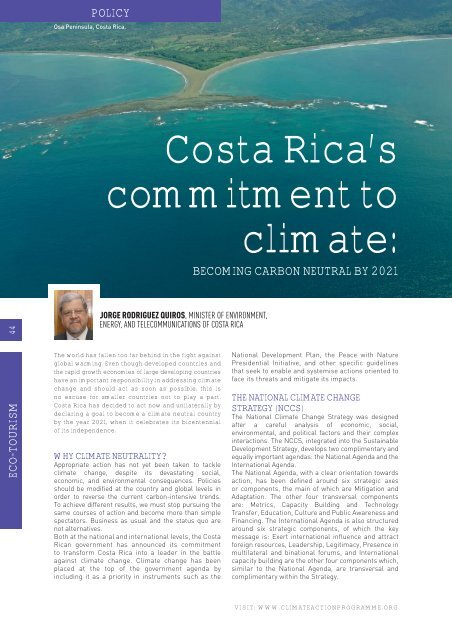Climate Action 2009-2010
You also want an ePaper? Increase the reach of your titles
YUMPU automatically turns print PDFs into web optimized ePapers that Google loves.
POLICY<br />
Osa Peninsula, Costa Rica.<br />
Costa Rica’s<br />
commitment to<br />
climate:<br />
BECOMING CARBON NEUTRAL BY 2021<br />
ECO-TOURISM 44<br />
Jorge rodriguez Quiros, Minister of environMent,<br />
energy, and telecoMMunications of costa rica<br />
The world has fallen too far behind in the fight against<br />
global warming. Even though developed countries and<br />
the rapid growth economies of large developing countries<br />
have an important responsibility in addressing climate<br />
change and should act as soon as possible, this is<br />
no excuse for smaller countries not to play a part.<br />
Costa Rica has decided to act now and unilaterally by<br />
declaring a goal to become a climate neutral country<br />
by the year 2021, when it celebrates its bicentennial<br />
of its independence.<br />
WHY CLIMATE NEUTRALITY?<br />
Appropriate action has not yet been taken to tackle<br />
climate change, despite its devastating social,<br />
economic, and environmental consequences. Policies<br />
should be modified at the country and global levels in<br />
order to reverse the current carbon-intensive trends.<br />
To achieve different results, we must stop pursuing the<br />
same courses of action and become more than simple<br />
spectators. Business as usual and the status quo are<br />
not alternatives.<br />
Both at the national and international levels, the Costa<br />
Rican government has announced its commitment<br />
to transform Costa Rica into a leader in the battle<br />
against climate change. <strong>Climate</strong> change has been<br />
placed at the top of the government agenda by<br />
including it as a priority in instruments such as the<br />
National Development Plan, the Peace with Nature<br />
Presidential Initiative, and other specific guidelines<br />
that seek to enable and systemise actions oriented to<br />
face its threats and mitigate its impacts.<br />
THE NATIONAL CLIMATE CHANGE<br />
STRATEGY (NCCS)<br />
The National <strong>Climate</strong> Change Strategy was designed<br />
after a careful analysis of economic, social,<br />
environmental, and political factors and their complex<br />
interactions. The NCCS, integrated into the Sustainable<br />
Development Strategy, develops two complimentary and<br />
equally important agendas: the National Agenda and the<br />
International Agenda.<br />
The National Agenda, with a clear orientation towards<br />
action, has been defined around six strategic axes<br />
or components, the main of which are Mitigation and<br />
Adaptation. The other four transversal components<br />
are: Metrics, Capacity Building and Technology<br />
Transfer, Education, Culture and Public Awareness and<br />
Financing. The International Agenda is also structured<br />
around six strategic components, of which the key<br />
message is: Exert international influence and attract<br />
foreign resources, Leadership, Legitimacy, Presence in<br />
multilateral and binational forums, and International<br />
capacity building are the other four components which,<br />
similar to the National Agenda, are transversal and<br />
complimentary within the Strategy.<br />
VISIT: WWW.CLIMATEACTIONPROGRAMME.ORG












